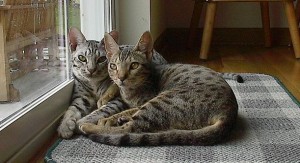About Ocicats
The Ocicat is a completely domestic breed of cat, bred to resemble a spotted wild cat. Unlike most spotted breeds, it carries no wild cat genetics, and has the sweet temperament of a completely domestic cat.
Ocicats are sleek and muscular, powerful cats with an exotic appearance. They are confident and intelligent, often learning to play fetch and go for walks on a leash with their owners. Ocicats will live, on average, 12 – 14 years.
The Ocicat resulted from an experimental breeding in the 1960s while attempting to produce an Aby-point Siamese, by Virginia Daly, a noted CFA breeder in Michigan.
For more information, take a look at the TICA Ocicat breed profile or the CFA Ocicat breed profile. There’s also a good short video on Ocicats, made by Animal Planet as part of the Cats 101 series.
History of the Ocicat
The first Ocicat was a happy accident, born in 1964. Mrs Virginia Daly, a cat breeder from Berkeley, Michigan, crossed a Siamese with an Abyssinian as part of a breeding program to create a Siamese cat with ruddy Abyssinian points. The cross produced a litter of kittens with the Abyssinian ticked coat pattern; a second generation cross produced a golden, spotted male kitten, who was named Tonga.
Tonga was neutered and sold as a pet, but a subsequent mating produced a similar tawny, spotted cat. This cat, Tonga’s brother, was one of the foundation cats used to create the Ocicat breed. Further cross-breeding with Siamese and Abyssinians plus the American Shorthair led to the creation of the Ocicat breed. The American Shorthair was included for the muscular build and size that it gave the Ocicat, as well as introducing the silver colour gene.
Ocicats are named after the ocelot they resemble, although they carry no wild cat genes. When Tonga was born, Mrs Daly’s daughter commented that he looked like a baby ocelot and suggested calling baby Tonga an Ocicat.
The independent Ocicat Info website maintained by Anne McCulloch has some good breed information and details of the history of the Ocicat, including an interview with Virginia Daly.
The Ocicat is accepted for showing and for championship status by most international cat registries and organisations, including TICA, the CFA, and the ACFA, as well as by the Australian and New Zealand national governing cat bodies.
